We drove a lot of cars in 2021, we’re reposting a few of our favorites here.
The 2021 Ford Bronco is sensational, and that’s coming from a life-long Jeep lover and former Jeep Wrangler engineer. Ford’s new SUV offers similar absurd off-road capability and roof-off fun as the current alpha predator — the Jeep Wrangler — and even offers some handling advantages. But the Bronco’s off-road capability and styling come with significant compromises. Here’s what I thought of the vehicle after a few hours behind the wheel.
(We’re taking an extra day today to celebrate Independence day. Enjoy some of our best stories from the last month or so.)
Fifteen years. That’s how long it took for an automaker to compete with the Jeep Wrangler Unlimited, the four-door version of Jeep’s most iconic off-roader, and the vehicle that has been bringing serious off-road capability and roof-off joy to the masses since 2006. And I do mean “to the masses” — even during the Great Recession, Jeep sold between 80,000 and 100,000 Wranglers annually in the U.S., with the vast majority being four-doors. After the recession, the figure quickly grew to a staggering 200,000, which is where things stand today. But, I suspect, not for long.
(Full Disclosure: Ford flew me to Austin, Texas, put me up in a hotel that was even fancier than the Lexus LX470 I lived in earlier this year, and fed me bread pudding.)
I asked The Blue Oval why it took an eternity to compete in a clearly booming segment, and the answer I got was that FoMoCo didn’t have a suitable plant, the appropriate platform, or executive buy-in. It’s not clear which of the three was the biggest factor (I’d guess the last, as the first two seem easily solvable), but in any case, the Bronco is here now, and Jeep’s position as the uncontested off-road champion is finally over.
What Is It?

The Ford Bronco is essentially a Jeep Wrangler built on the Ford Ranger platform. That’s obviously an oversimplification, but the reality is that the Bronco unabashedly borrows heavily from the Wrangler’s tool kit: The roof and doors come off, there’s tons of ground clearance, the overhangs are tiny, tires on higher-level trims are big and aggressive, gearing (in the transmissions, low-range-equipped transfer cases, and differentials) is short to ensure sufficient torque at the wheels to keep the vehicle moving even up steep grades, and there are a bunch of optional off-road features like lockers and a sway bar disconnect.
Ford builds the Bronco alongside the Ranger — which shares a similar architecture — at the Michigan Assembly Plant in Wayne, Michigan. Both Fords have bodies that are bolted to ladder frames, offer a solid rear axle and independent front suspension, and come with a 2.3-liter turbocharged inline-four (making 270 horsepower in the Ranger, 300 in the Bronco) mated to a 10-speed automatic. The Bronco adds an optional 330 horsepower 2.7-liter turbocharged V6 and a seven-speed Getrag manual transmission.
One of the Bronco’s biggest selling points over its Wrangler competitor is that independent front suspension, which allows for a modern electric rack-and-pinion steering system. This suspension setup should, in theory, give the Bronco significantly better on-road ride and handling at the expense of wheel articulation. I found that to be only partly the case.
First Things First: The Manual Shifter Is Good
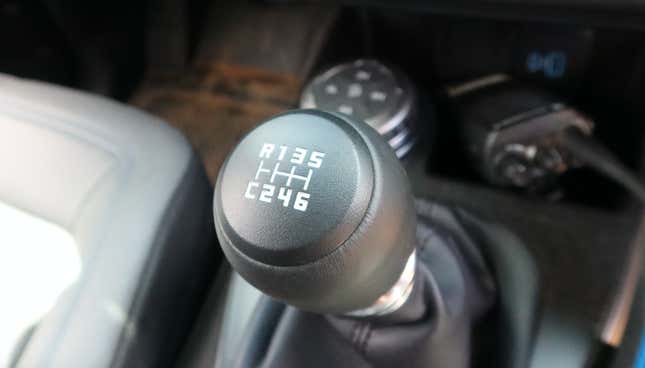
When the Ford Bronco debuted last summer, people asked me if I preferred it to the Wrangler. My answer was that my choice would depend on a number of factors, with a key one being the feel of the manual transmission.
Jeep’s latest-generation Wrangler JL discarded the JK Wrangler’s Daimler-sourced six-speed NSG370 manual transmission in favor of a more refined Aisin D478 unit that is isolated from the gearbox via shift-cables (the NSG370's shifter mounted directly to the gearbox, and vibrated quite a bit). The result of Jeep’s push for refinement is a loss of shift feel; the Wrangler’s stick no longer provides that satisfying “clunk” when going into gear, and that’s a real shame.
The Ford Bronco’s Getrag seven-speed also shifts gears through cables, but as I found during my time behind the wheel, it’s actually damn good.
Before I got to row through the gears, I went to release the park brake, searching around the center console for a lever or button. After a while, I learned that the Bronco comes with an electronic park brake that the driver activates by pulling a switch located where a typical foot-brake’s release handle might be — on the lower part of the dash to the left of the steering column (see below). This isn’t a great design.
It’s already a bummer that an off-road vehicle like the Bronco doesn’t have a cable-style park brake that you can just yank in case of an emergency (though I acknowledge benefits of electronic park brakes; one is safety: These brakes can actuate themselves when a door is open, for example). The fact that this electronic park brake requires the driver to lean over and look down is silly, even if I realize that, over time, the driver might get used to the location.
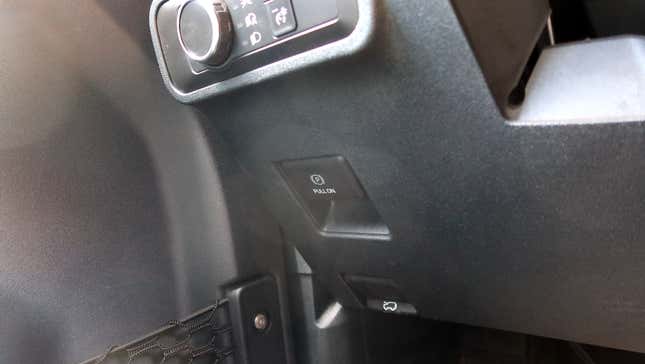
Anyway, back to the shifter. The throws are medium-length, possibly on the long side (just as I prefer it on trucks and SUVs), and provide a satisfyingly notchy sensation when sliding into gear. Old-school direct-shift manuals like the T-177 in my Jeep J10 and the AX-15 in my Jeep Grand Cherokee feel a little more positive and raw, but the Bronco’s Getrag definitely feels nicer than I remember the JL Wrangler’s shifter feeling.
The Bronco’s clutch pedal was a little too soft for my taste, and the 2.3-liter turbocharged engine definitely needs boost to have any amount of low-end torque. Starting off in first gear, I found myself lugging the engine a bit as the motor began building boost, taking a moment to accelerate out of the hole. Once boost kicks in, though, the 300 horsepower four-cylinder felt powerful enough — roughly the same as the Wrangler 2.0-liter and 3.6. And though Ford’s 2.3 doesn’t sound amazing, it’s a little more entertaining than Jeep’s gas engine options.
I’ll also mention that third gear feels tall; shift into three while driving below 30 mph, and get ready to watch the first derivative of your vehicle’s velocity with respect to time fall towards zero.
Many of these things — the gearing, the park brake location, the need to build boost to make good torque down low — are things I’d get used to over time, and in the end, I think the seven-speed is solid and a major advantage for the Bronco over the Jeep. Especially to enthusiasts.
The On-Road Ride Is Just Okay

Ford set up a route that took journalists through windy canyon roads along Texas’s Colorado River, ultimately ending at Ford’s “Off-Roadeo” — one of many off-road parks that Ford has set up around the country to teach new Bronco and Bronco Sport owners how to tackle harsh terrain.
While on the route, I enjoyed the view through the Bronco’s front windshield. Visibility is excellent; the hood, which is raised where it meets the fenders, appears low and offers a good look at the ground just ahead, and the two brush guard cable mounts provide a helpful visual reminder of the vehicle’s width.


The view out of the back window could be better, with the rear spare tire, rear wiper motor, center high mounted stop lamp, rear C-pillar-mounted speakers, and cross-car roof trim obscuring visibility a bit more than I’d prefer. That said, given the visibility of many modern vehicles, with their giant C/D-pillars, this isn’t too bad:
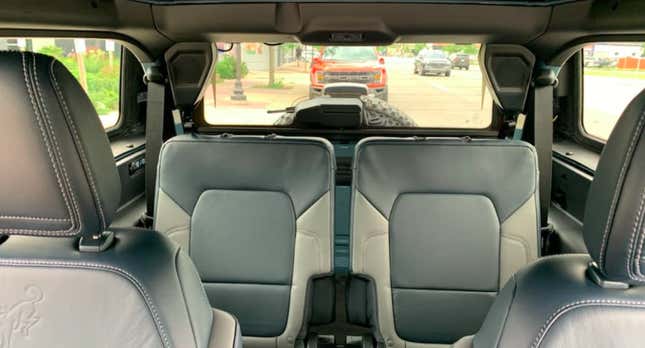
As for ride and handling, the Ford Bronco’s independent front suspension — particularly the reduced unsprung weight, the fact that an input (i.e. bump) at one wheel isn’t translated to the other, and most importantly the significantly more precise rack and pinion setup — should give the vehicle a major edge over the Wrangler on the tarmac. But it’s not that simple.
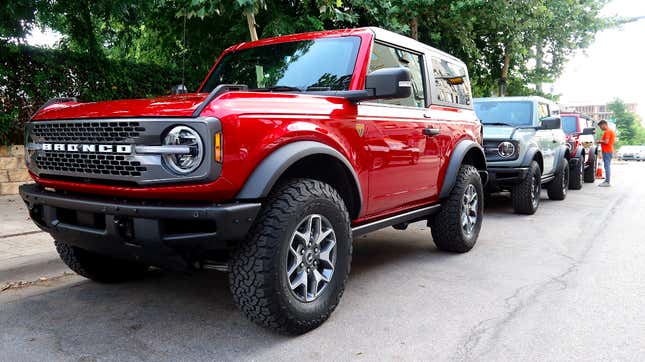
To be sure, the Bronco’s steering is much more precise than the Wrangler’s. The Jeep’s steering system is antiquated, using a gearbox to rotate a pitman arm, which pushes a drag link that’s hooked to one steering knuckle, which is hooked to the other steering knuckle via a thick tie rod (If none of that made sense to you, don’t worry: I explain it all in this technical deep-dive). The Jeep’s steering design is inherently sloppy and imprecise, with what feels like 10 degrees of play in the wheel.
The Bronco’s steering is sharp. Crank the wheel and the front tires will turn almost instantly, though that doesn’t mean the vehicle itself will change directions right away. There is a significant transient response time, as the tires need to flex, the vehicle’s chassis needs to flex, the machine needs time to lean, and then the Bronco begins turning in. The Badlands model that I was driving was tall, softly sprung, and its 33-inch tires had massive sidewalls that howled in tight turns. The Bronco may not have a big stick axle under its nose, and its steering may be much tighter than the Jeep’s, but it’s still far from a sports car in the corners.
There’s plenty of body roll and there’s lots of brake dive; in fact, on my two-door test vehicle, I found stability under hard braking — especially with the wheel turned even slightly — to be marginal, with the nose diving and then wanting to dart in towards the turn while the rear — now largely unloaded — wanted to continue straight.
Luckily, the vehicle’s traction control system cut in and cleaned everything up. Ford engineers are adamant that the two-door Bronco is stable even with stability control off, and they also told me that the driver’s seat on the two-door bronco is located near the vehicle’s yaw center. This, they told me, could have amplified the sensation of spinning due to the lack of yaw delay.
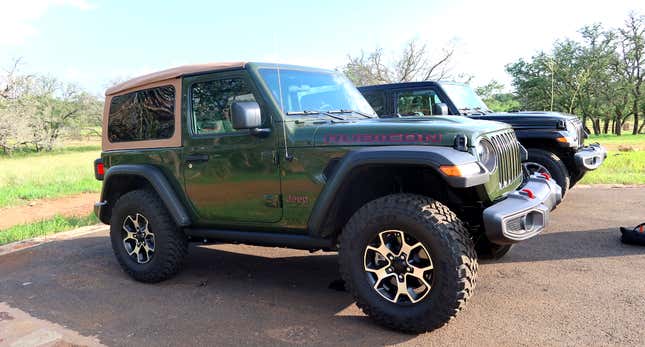
I will say that I test drove a Jeep Wrangler Rubicon two-door, and under similar conditions, it too got light around the rear and felt like it wanted to rotate, but it never quite felt as sketchy as the Bronco did because, to me, it felt like the stability control cut in sooner. I bet Ford can clean up the Bronco two-door’s braking behavior with a bit of software.
In any case, this wasn’t a big deal in most driving conditions, and at least to some degree, you’d expect a short-wheelbase, front-engine, tall off-roader with huge tires to be dynamically compromised under braking. Still, I think there’s room for improvement.

While we’re on the topic of the Wrangler, I found its ride to be a little smoother than the Bronco’s. Perhaps the Jeep is a bit more softly sprung, or maybe there were other factors at play, but on the decent Texas roads I was driving on, the Wrangler glided. At the same time, the Jeep felt “floaty” and less stable at speed than the Bronco — as if the Jeep’s suspension and cabin were in two different time zones, whereas the Bronco’s body felt more controlled.
I also noticed very little head-toss when driving over bumps in turns with the Bronco; Wranglers are known to wobble back and forth when hitting bumps mid-corner.
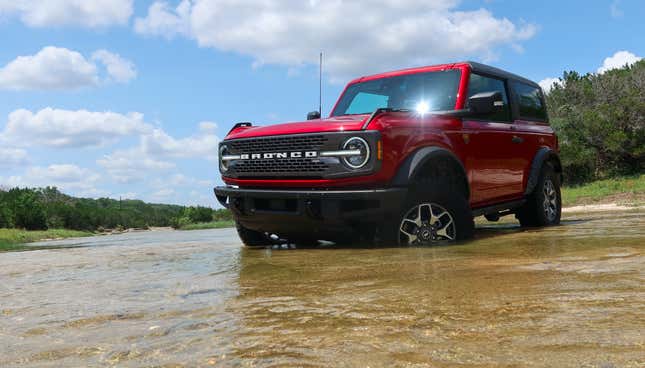
A lot of what I’m typing is based on subtle feelings. I’d like more time behind the wheel of both to really nail down the differences. But from my short drive, I felt the Bronco’s steering was tighter, the Jeep’s ride was a bit smoother when driving straight on reasonably-maintained roads, the Bronco handled bumps in turns better, both vehicles had plenty of brake dive and body roll (with the Jeep’s stability control making it feel more stable under hard braking in turns), and neither vehicle really took kindly to being thrown into corners.
The Cabin
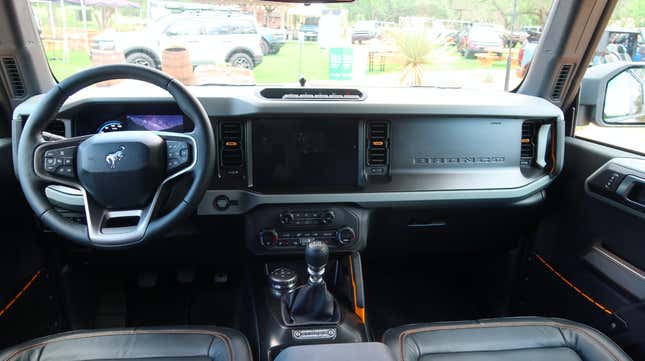
I love the Bronco’s cabin. The way the screen is nicely integrated into the dash, the fit and finish (especially the little colorful rubbery bits on the vents), the infotainment system’s user interface, the seat comfort — it all just works beautifully. It’s a fairly understated, rugged cabin that doesn’t feel cheap, and that’s pretty much what anyone could possibly want in an off-roader.
I will say that the little grab handles on the dash aren’t that useful. I parked in a creek (see image above), and upon opening the door to enter, I found myself hunting for something to grasp so that when I stepped up into the cabin I wouldn’t have to rely on one foot’s traction on the algae-covered creek bed. Leaning far forward to grab the handle on the dash was silly; I’d like something hanging from the roll hoop just to the left of the driver’s headrest.
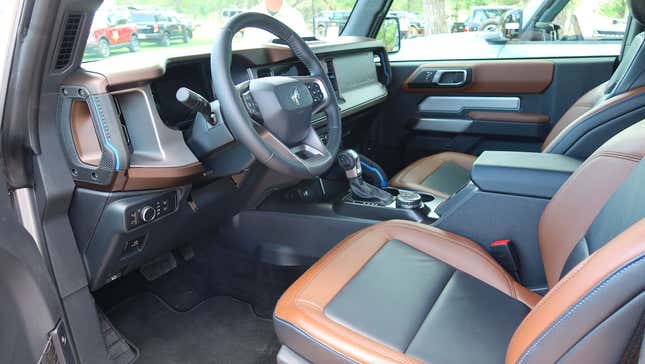
I also noticed that the steering wheel airbag protrudes quite a bit, causing me to honk the horn with my forearm often while driving off-roading. But that’s because I drive with one arm, like a fool.
The final thing I’ll mention about on-road driving is that there is wind noise. The Bronco has a squared-off, upright design, and though the windshield does have a significant rake to it, all those sharp corners and blunt profiles normal to the direction of travel are going to create a bit of a racket. This is a tradeoff for the chunky off-road look, and one well worth making in my opinion.
Removing The Roof And Doors
Since one of the Bronco’s main selling points is its convertible roof and removable doors, I shot a little video showing what it’s like to undress Ford’s new off-roader.
The soft top and three-piece hard top work similarly to the Wrangler’s, so I won’t show those. The doors, though, are a little different. Whereas the Wrangler requires you to undo some interior trim to remove an electrical connector, the Bronco’s connector is more easily accessible and removable, located between the two door hinges on the A-pillar. Whereas the Wrangler requires you to remove two torx bolts, a check strap, and a limiting strap/wire, the Bronco simply requires removal of two hex bolts.
Here’s a look at the Wrangler’s setup:
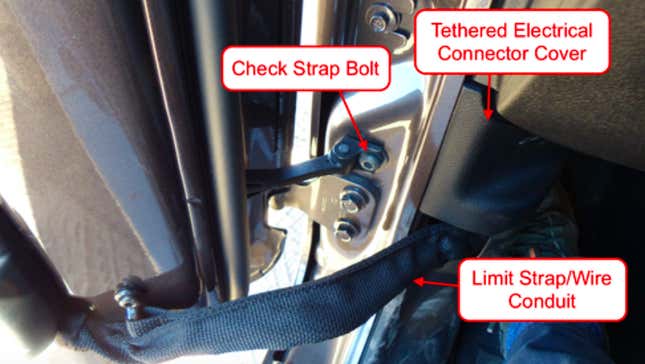
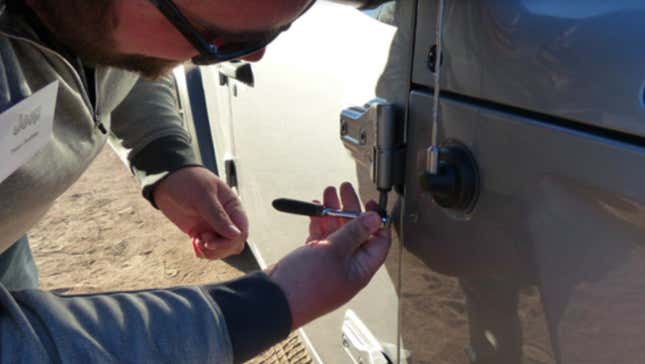
And here’s the Bronco’s. Step one is to remove this connector:
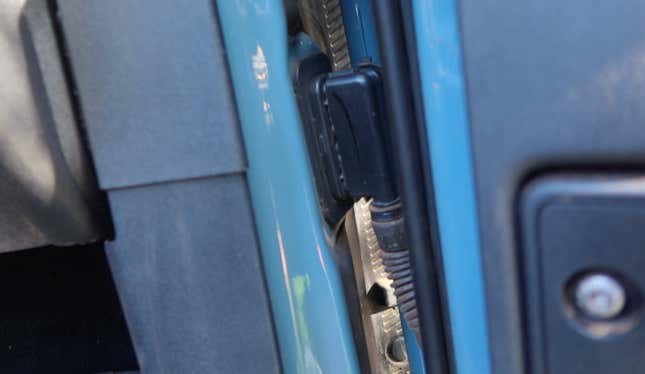
With that unhooked, a spring-loaded door swings over the electrical port, sealing it from dirt and moisture (though I have to say, the little blue rubber seal was flopping all over the place, and I wouldn’t trust it for a second to keep water out of the port):

With the connector unhooked, you just remove these two hex bolts:
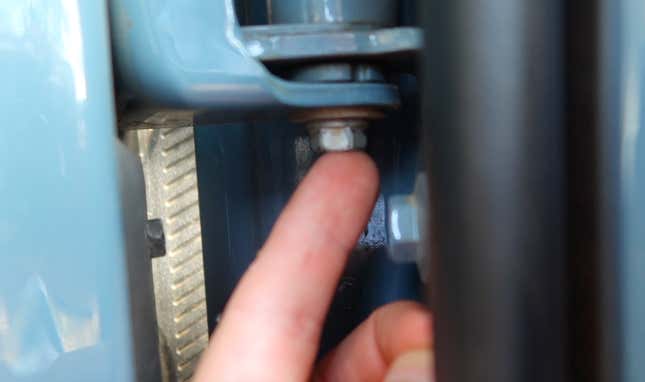

Reinstalling the door involves first threading a little conical guide pin into the body-mounted door bracket/hinge:
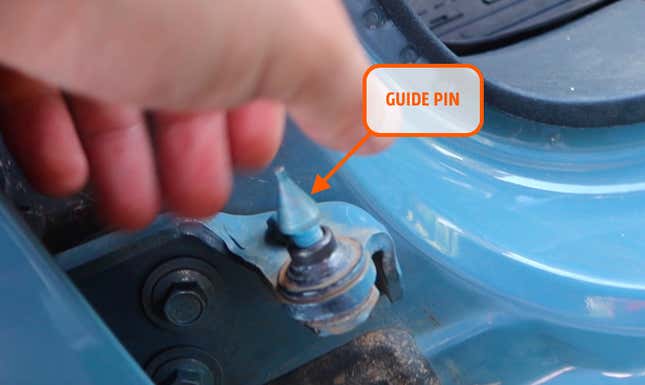
This makes it easier to guide the door’s lower hinge hole into place:

The next step is to plug the connector back in, and from there, you just unthread the guide pin by hand and crank down the two hex bolts into the hinges. That’s it. It’s quick and easy, even if the tiny, easily-losable guide pin may not be the most elegant thing I’ve ever seen.
Off-Road Capability
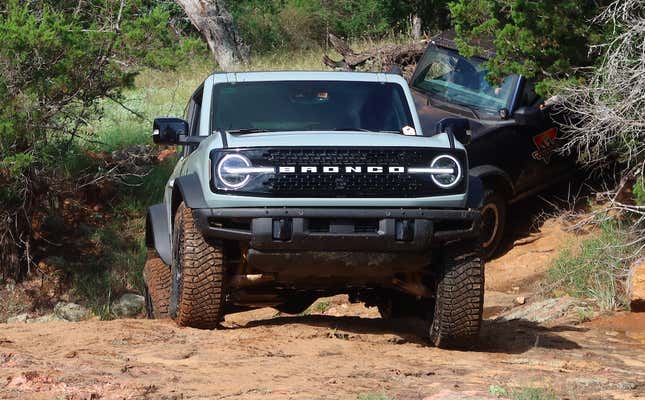
Ford’s off-road course just outside of Austin, Texas wasn’t particularly challenging for a seasoned off-roader, and even a bone-stock base-model Jeep Wrangler would likely have walked through it without too much fuss. Still, you don’t have to push a vehicle to its limits to get a good understanding of what those limits are. After just a few trails, it became obvious that the Bronco’s limits are serious.
The 2021 Ford Bronco is one of the greatest stock off-road vehicles ever produced, and I can say with confidence: I don’t know if a stock Jeep Wrangler is more capable.
Let’s walk through the Bronco’s most impressive off-road attributes.
Geometry
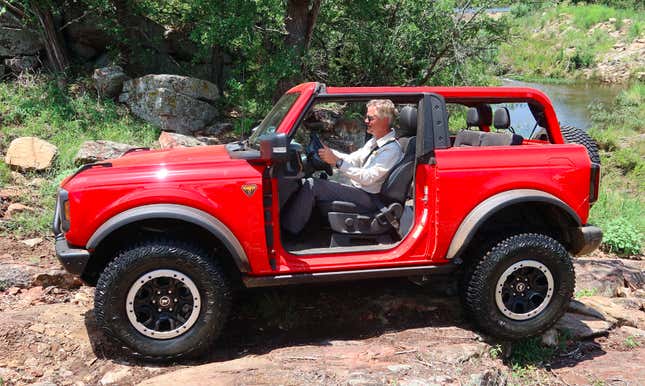
The single most important ingredient a vehicle needs to be a true off-road brute is advantageous geometry. That means short overhangs, lots of ground clearance, and an optimally-sized wheelbase. In those areas, the Bronco is stellar, thanks in large part to available 35-inch tires.
The 43 degree approach angle, 29 degree breakover angle (27 on four-door) and 37 degree departure angle meant getting onto, over, and off of even the gnarliest of obstacles without dragging bumpers or underbelly was no problem.
The Bronco is wide, but the tight steering radius made it feel nimble nonetheless. The Trail Turn Assist function, which uses ABS to drag the rear inside wheel to help the vehicle navigate a tight turn, works well, though it’s a bit odd at first having to give the vehicle so much gas to power through the brakes.
Traction And Gearing
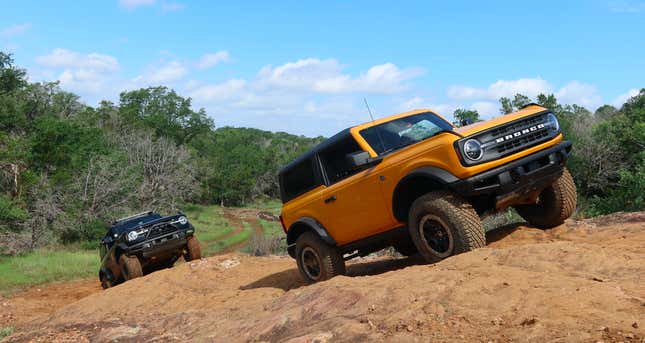
But just because a vehicle can get its tires onto an obstacle doesn’t mean that vehicle can scale it. The tires need grip and torque, and in both areas, the Bronco is more than adequate.
Even without the locking differentials on, the 35-inch Goodyear Territory tires clawed dirt and rocks, and moved the Bronco along confidently. The 3.06 to 1 low-range gearing, along with the short axle ratios and short first gear ratios on both the automatic and manual meant the wheels always had more than enough torque to thrust the Bronco up and over steep terrain.
The manual’s 6.588 to one crawler gear — accessed by pulling up a collar (just like reverse) — made the Bronco borderline unstallable and allowed for slow, controlled climbs over technical terrain where too much speed risked body damage.
If you do stall the vehicle while on a slope, the Bronco allows you to start the vehicle in gear so you don’t have to ever use the clutch while on a steep grade (hill start assist would help you out anyway, but still — you generally don’t want to be playing around with a clutch on a sketchy steep grade if you can avoid it).
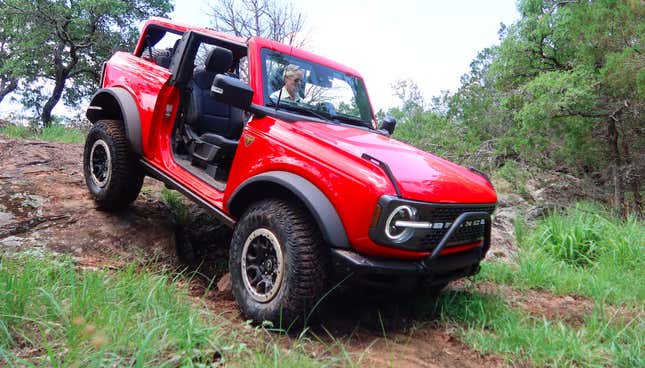
Here’s a little video review of the crawler gear and a look at how to start it without the clutch. The man at the helm is legendary off-roader Fred Williams, host of Motor Trend On Demand’s Dirt Everyday:
You’ll notice in the clip above that Fred tries climbing a hill without lockers, and spins one tire on each axle. To avoid tearing up the trail, Fred simply presses the extremely-satisfying rubberized rear locker button on the top of the dash, and the Bronco just walks right up the slope.
The Bronco’s lockers — which help propel the vehicle forward by ensuring that all four wheels spin at the same rate and can receive plenty of torque from the engine — are highly effective, and they’re quick to engage, even while on a steep slope.
Articulation
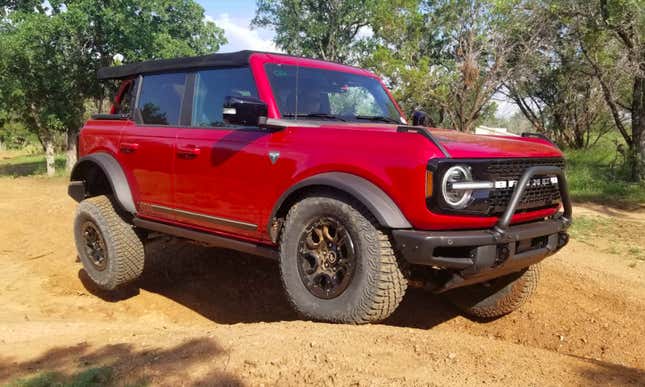
One of the main areas where a solid axle tends to beat out an independent suspension (at least on production vehicles) is wheel articulation. A basic stick axle, especially with a disconnected sway bar, tends to want to keep all four tires on the ground at all times, whereas an independent front suspension like the one on the Bronco has a tendency to lift a tire even if the individual front wheels have more travel than those on the stick-axle counterpart. It’s just the nature of the two designs. Check out this Wrangler flexing; all four tires remain on the ground despite the right rear being what looks like two feet higher than the right front:
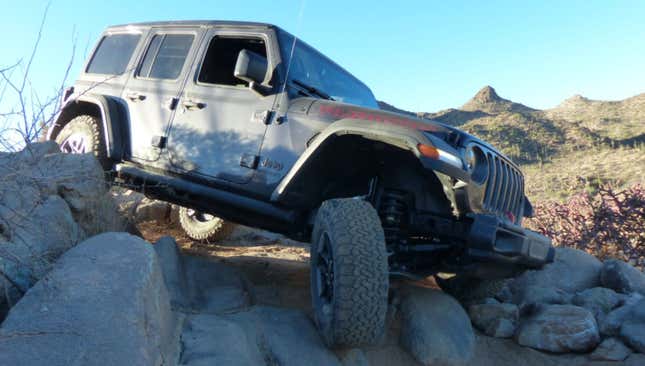
The Bronco’s articulation is decent with the sway bar disconnect function engaged. As shown in the clip below, it takes quite an uneven surface to force a tire off the ground, and that’s a good thing, as having all four tires on the surface means the vehicle has more grip to help climb obstacles, and it makes the ride feel less tippy.
Though the Wrangler likely flexes better, offering its driver more confidence while traversing uneven terrain (lifting tires off the ground can feel sketchy), I was impressed with Bronco’s flex. I will mention, though, that it’s not just articulation that makes a solid axle so good for an off-road vehicle; it’s also durability and lift-ability.
I’ll discuss the former in a bit, but the latter is simple: Lifting a solid-axle machine is easy, since the only driveline angles that change with a lift are the driveshaft angles. Driveshafts are relatively long, and can generally accommodate quite a bit of lift before binding. Plus, solid axles can easily be rotated to keep driveline angles in check.
Lifting a vehicle with independent suspension, however, tends to change halfshaft angles, reducing the longevity of the CV joints on those halfshafts. There are things one can do to counteract this, but it’s undeniable: lifting a solid-axle vehicle is much easier than lifting a vehicle with IFS.
The good thing is that the Bronco comes from the factory with 35s, so there’s less of a need to jack the Bronco up to clear big tires. This was a brilliant move from Ford.
High-Speed Off-Roading

Ford let journalists ride along with off-road racing drivers Shelby Hall and Loren Healey. I rode with the former, an incredibly talented rally driver who showed me where that independent front suspension really thrives: dirt and gravel roads.
I’ve taken many solid axle Jeeps off-road on beat up dirt roads over the years, and the two most taxing conditions tend to be mid-turn bumps and washboards, which are dirt or gravel roads that have developed waves due to heavy vehicle travel.
Bumps in turns tend to throw solid-axle Jeeps around like rag dolls, causing loads of head-toss for passengers. Washboard roads cause the front axle to violently shake up and down, sometimes feeling like it’s reaching some sort of resonance, making the drive downright uncomfortable and significantly reducing front-end grip.
Though I’d like more time to test the two machines at high speeds off-road, it’s clear the Bronco’s front suspension design is much better suited to blasting through dirt and gravel trails than the Jeep’s. I was impressed. (It’s also worth noting that the Bronco’s front suspension is better suited to avoid Jeep’s trademark death wobble).
Pedal Calibration

One of the Ford Bronco’s main triumphs is its pedal calibration. This is an area that so many automakers struggle with, especially on vehicles with boosted engines. Often times, you go to tap the skinny pedal, and a surge of power forces the vehicle forward with far more vigor than you were hoping for, causing you to have to left-foot brake to maintain control over a technical obstacle.
With the Bronco, this isn’t a problem. The gearing plays a big role here, of course, but Ford’s pedal calibration deserves praise because it allows the driver to crawl up and over obstacles extremely slowly with real precision. Just gently press your big toe on the rightmost foot control, and watch as the vehicle responds ever so slightly, gradually increasing engine torque to get you over whatever big boulder lies ahead.
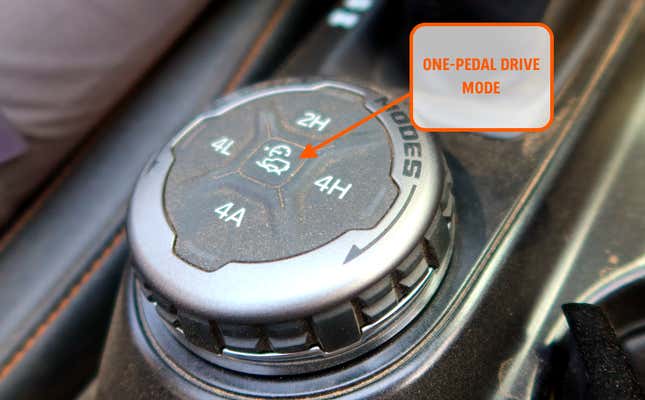
Ford does have a “One-pedal drive” option that gradually applies the brakes as soon as you begin to lift off the gas, essentially mimicking left-foot braking used by off-roaders to control speed. I didn’t really enjoy using this. Letting off the gas pedal yielded abrupt stops; I found the whole experience jerky and annoying, though with a bit of time, I likely could have figured out how to modulate that gas pedal in a way that allowed the Bronco to smoothly navigate the trail.
I just had absolutely no desire to continue practicing because the Bronco’s gearing and pedal calibration was so good that I barely had to left-foot brake.
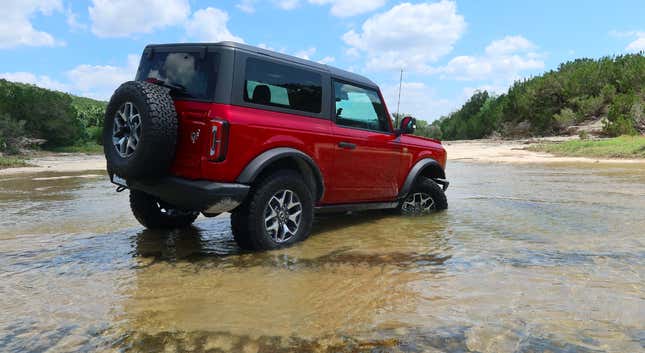
While we’re on the topic of off-road software, the Bronco Badlands offers seven modes: Normal, Eco, Slippery, Mud/Ruts, Baja, Sand and Rock Crawl. They adjust pedal mapping, the transmission shift schedule, locker status, stability control behavior, and much more. To activate the modes, you rotate the dial above. This works well enough, but the buttons at the center of the dial aren’t my favorite.
The Jeep Wrangler has a mechanical lever that you pull to activate four-wheel drive. This is not only quicker (particularly in low range) than the Bronco’s electronic shifter, but it feels more reliable. The idea of an electronic switch failing, and the vehicle being unable to go into four-wheel drive isn’t a pleasant thought. Even if Ford has failsafes in place (and I’m sure Ford does), this is a perception thing.
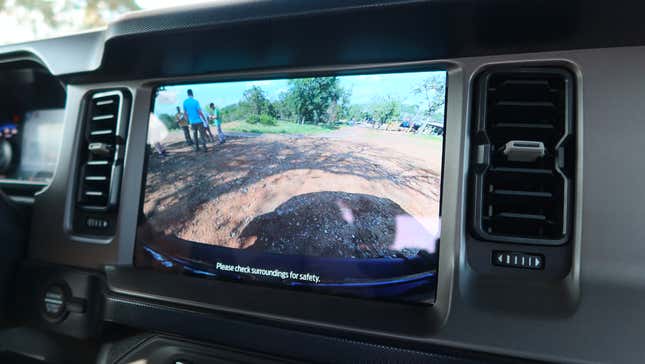
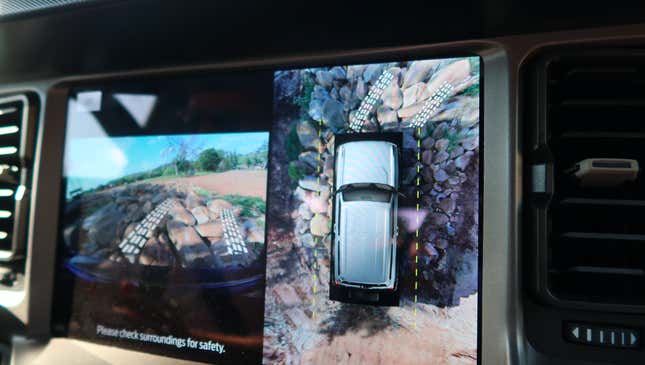
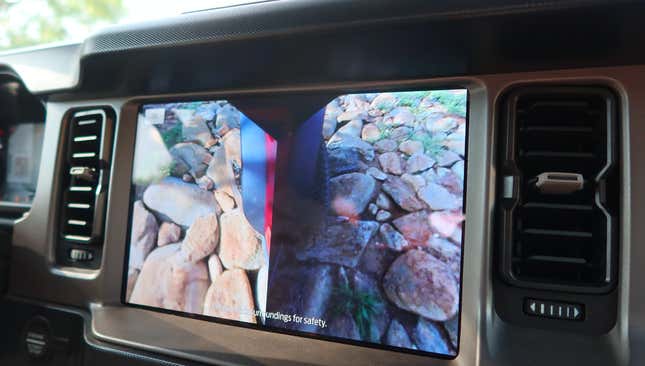
One of the biggest electronic features that contribute’s to the Bronco off-road competence is the available camera system. The fact that the front camera view shows the front bumper in the frame is a huge help in spotting the vehicle over off-road terrain. The side cameras mounted on the mirrors are also clutch, helping show the location of the front tires.
With good forward visibility through the windshield, excellent camera views, highly effective locking differentials, decent articulation, grippy tires, short gearing, and a superb pedal calibration, the Ford Bronco gives its driver confidence, and that’s a huge deal in the world of off-roading.
Underbody Protection And Durability
As you can see in the clip above, the Ford Bronco’s underbody is covered in armor. The engine, steering rack, sway bar, transfer case, and fuel tank are all protected by thick steel. The nylon transmission pan (not shown) isn’t covered, though it’s located high above the frame rails and just above the front axle, so I don’t suspect it’s likely to sustain much trail damage.
Surprisingly, unlike the Wrangler, which always protects its fuel tank and transfer case with steel skid plates, some lower-trim Broncos come without protection. They look quite vulnerable underneath, especially since the high-density polyethylene fuel tank hangs so low. Here’s a look at an unprotected Bronco I filmed just outside of the Michigan Assembly Plant:
So I suggest if you plan to do any off-roading in a Bronco, make sure you opt for the skid plates.
As for other areas where durability might be a concern, check out my deep-dive for further discussion. The Wrangler’s solid axle design does have thicker, beefier looking steering parts when compared to the Bronco’s small tie rods, and the Jeep’s axle shaft’s universal joints are definitely an advantage over the Bronco’s CV joints when it comes to repair-ability. But some of the most legendary overlanders ever (Toyota Land Cruiser 100 Series) utilize IFS, so clearly it works and can last.
Conclusion

Engineering is a game of compromises. If an automaker doesn’t want to build a boring car that’s decent in most areas, but instead wants to offer a vehicle that is stellar in just a few, then that automaker will have to give something up. And figuring out what to give up and to what extent is an art form mastered by only the finest automobile engineers and product planners.
The Ford Bronco is an example of a beautifully engineered vehicle because it’s compromised in all the right ways. Sure, it only gets between 17 MPG and 21 MPG combined and sure there’s some wind noise in the cabin, but who cares when the Bronco looks like that?
Sure, the vehicle has lots of brake dive and body roll, but who cares when it can do that off-road? Sure, the independent suspension doesn’t quite flex like the solid axle and may not be as easy to lift, but the electric power steering is tight, more efficient than the Wrangler’s electro-hydraulic system, and allows for advanced safety features like Lane Keep Assist. Not to mention, IFS offers good high-speed off-road handling, and with Ford offering 35-inch tires, a major disadvantage — the difficulty of lifting an IFS vehicle — becomes just a tiny blemish.
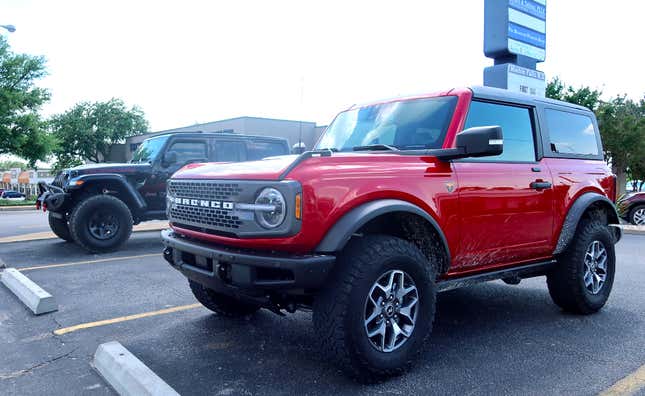
The Ford Bronco is a compromised machine, but the best vehicles of all time tend to be. And in the Bronco, the world has another soulful and fun SUV that dominates the trails and looks absolutely epic doing so. It’s an exceptional Wrangler competitor, and I can’t wait to put the two head-to-head off-road, in what could end up being the most extreme off-road slugfest the world has ever seen.